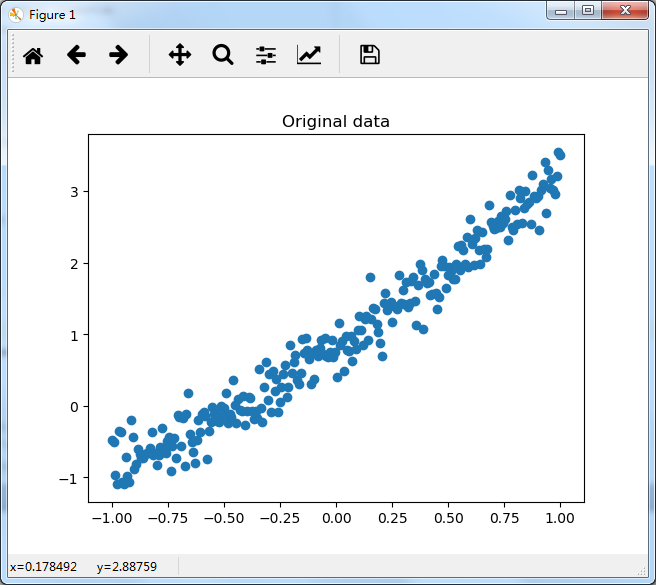测试数据集

结果
Average cost for epoch 1:[[0.00205521]]
Average cost for epoch 2:[[0.00631908]]
Average cost for epoch 3:[[0.05993859]]
Average cost for epoch 4:[[0.00125682]]
Average cost for epoch 5:[[0.01064789]]
Average cost for epoch 6:[[0.00989342]]
Average cost for epoch 7:[[0.0006353]]
Average cost for epoch 8:[[0.04441563]]
Average cost for epoch 9:[[0.00129304]]
import tensorflow as tf
import numpy as np
from sklearn.utils import shuffle
import matplotlib.pyplot as plt
trainsamples = 200
testsamples = 60
#Here we will represent the model, a simple imput, a hidden layer of sigmoid activation
def model(X, hidden_weights1, hidden_bias1, ow):
hidden_layer = tf.nn.sigmoid(tf.matmul(X, hidden_weights1)+ b)
return tf.matmul(hidden_layer, ow)
dsX = np.linspace(-1, 1, trainsamples + testsamples).transpose()
dsY = 0.4* pow(dsX,2) +2 * dsX + np.random.randn(*dsX.shape) * 0.22 + 0.8
plt.figure() # Create a new figure
plt.title('Original data')
plt.scatter(dsX,dsY) #Plot a scatter draw of the datapoints
plt.show()
X = tf.placeholder("float")
Y = tf.placeholder("float")
hw1 = tf.Variable(tf.random_normal([1, 10], stddev=0.01)) # Create first hidden layer
ow = tf.Variable(tf.random_normal([10, 1], stddev=0.01)) # Create output connection
b = tf.Variable(tf.random_normal([10], stddev=0.01)) # Create bias
model_y = model(X, hw1, b, ow) #
cost = tf.pow(model_y-Y, 2)/(2) # Cost function
train_op = tf.train.AdamOptimizer(0.0001).minimize(cost) # construct an optimizer
# Launch the graph in a session
with tf.Session() as sess:
tf.initialize_all_variables().run() #Initialize all variables
for i in range(1,10):
trainX, trainY =dsX[0:trainsamples], dsY[0:trainsamples]
for x1,y1 in zip (trainX, trainY):
sess.run(train_op, feed_dict={X: [[x1]], Y: y1})
testX, testY = dsX[trainsamples:trainsamples + testsamples], dsY[0:trainsamples:trainsamples+testsamples]
cost1=0.
for x1,y1 in zip (testX, testY):
cost1 += sess.run(cost, feed_dict={X: [[x1]], Y: y1}) / testsamples
print("Average cost for epoch " + str (i) + ":" + str(cost1))
dsX, dsY = shuffle (dsX, dsY) #We randomize the samples to implement a better training